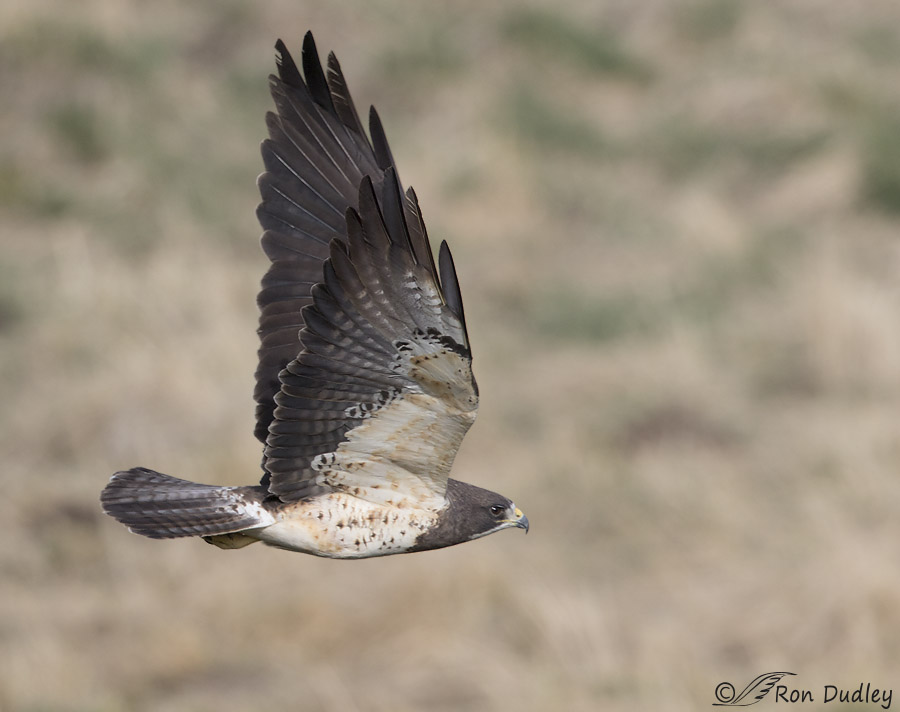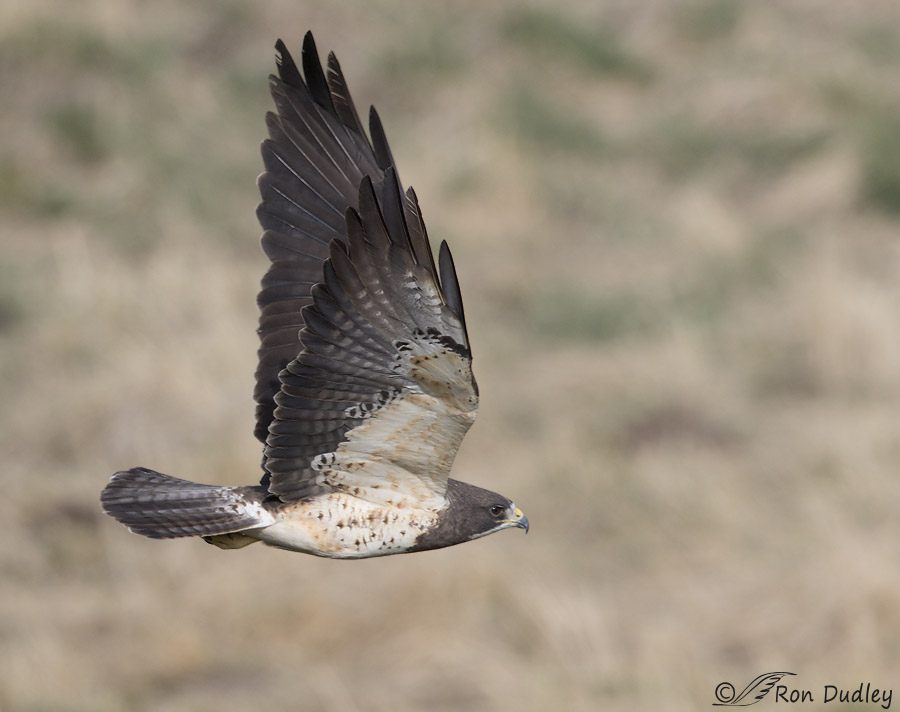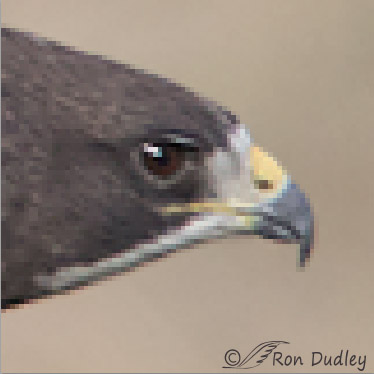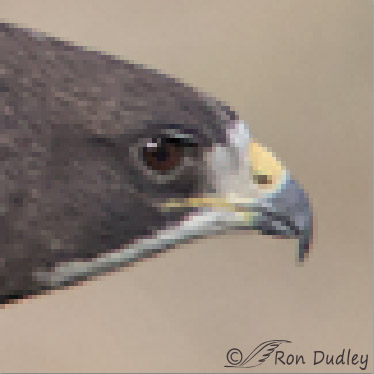Sometimes my eye is fooled by my first or even subsequent glances at an image.

1/2500, f/6.3, ISO 500, Canon 7D Mark II, Canon EF500mm f/4L IS II USM +1.4 tc, not baited, set up or called in
I photographed this light morph Swainson’s Hawk 10 days ago in southwest Montana. When I first saw the image on my big screen after returning home my initial impression was that the head was slightly soft so I passed it by and a few days later while I was culling images I almost deleted it. But something made me take a closer look and it was only then that I began to suspect that my eye was being fooled by that funky-looking catch light.
One of the ways that I’ve always judged image sharpness is by evaluating the catch lights in the eyes. A pinpoint catch light is one indicator that the image (or at least that part of the image) is sharp. But this catch light is different – to my eye, at this resolution, it almost looks like a double catch light with the two components right next to each other which makes it look blurry to me. So I wondered if my eye was being fooled into thinking the entire head was slightly soft because the catch light appeared to be soft.

So as a test I decided to reprocess the image and remove part of the catch light to make what was left of it appear sharper and see if it made a difference to my overall impression of the sharpness of the head. It did. In my judgment the entire bird, including the head, now looks more than acceptably sharp. The only difference between these first two images is a few cloned pixels in the catch light in the second image.

A massive crop reveals what I did. After resizing the entire image to 900 pixels wide for web presentation and then cropping to show only the head this is what the first version of the image looks like. At this resolution each tiny square in the image is a single pixel. The original catch light consists of 7 pixels.

After cloning and toning down several pixels of the catch light this is what it looks like in the second image.
Normally I never alter catch lights in my work flow. I don’t add them if they’re not in the original image and I don’t do sneaky little things with them at the pixel level (though I do occasionally brighten or tone down a catch light that already exists).
But this was an experiment. I was quite surprised to learn that my perception of the sharpness of the head of the bird was being influenced by the apparent softness of the original catch light. I’ve never been highly skilled at evaluating sharpness anyway so learning another technique for doing it more accurately was a valuable lesson for me.
I’m curious to know if the first impression of others is that the head of the hawk in the first image is less than sharp and that sharpness there seems to be improved by the changes I made in the catch light in the second version of the image.
It may only be me, after all I am a little strange…
Ron


Ron, I saw just what you described- that in the first, the whole head looks blurred even though it’s not. Strangely, even the underwing looks more precise to me in the second. Our eyes don’t really see what is there. We see what our brains interpret. I think you’ve stumbled upon a wonderful example.
The elongated shape of the catch light in the first image does not interfere with my perception of image sharpness. I am no photographer and use just 8 x 42 binoculars in the field; so, I am not accustomed to viewing wild things with the amount of magnification used with a scope or in your photos.
For me, the angle of the light entering and/or leaving the eye just makes a different shape in the field and doesn’t effect how well I can ID the bird. The plumage details and edge of both images are the same and would be a bird that was pretty close to me while birding.
“For me, the angle of the light entering and/or leaving the eye just makes a different shape in the field and doesn’t effect how well I can ID the bird”
I’m sure it doesn’t effect your field ID’s, Pam. But as a photographer I have to be concerned with the fine details that present in my images, often taken at 1120 effective mm. Quite a difference between you and I in some ways – you’re apparently a birder and I’m a bird photographer. Some of our goals are different but we share a love of birds and nature.
I was interested in and appreciate your comment from the perspective of a birder. When you’re watching a bird through your bins I suspect you’re looking for things like field marks for ID, plumage variations, sex of the bird, possible rarities, etc. I sometimes (usually) don’t have time for that in the field. When I’m looking through my lens I’m mostly watching for good light angles, interesting poses and behaviors, compositional opportunities and catch lights. I look for the rest of it when I’m reviewing my images…
Yes Ron, we are looking for a bit different opportunities in the field. I do enjoy watching behavior and when I see something that is a beautiful composition, the image stick in my brain more clearly. I really enjoy the beauty and detail in your blog. It teaches me a lot as a birder.
I like both images. It is the plumage rather than the catch light which usually draws me in (drooling). And the catch light in that first image is slightly elongated – which adds to the impression of speed and power.
I wish I could appreciate that original catch light as much as you do, EC. As it is the only way I’d use the image is to modify it and I’m very reluctant to do that.
Ron, my first impression of the image is that is great, nice and sharp. My eyes first focused on the dark contrast of black feathers in the primary coverts on the underwing, the second thing I notice is the beautiful deep brown, almost purplish, color of the primaries. If you had not mentioned the “broader” catch light, I would have never even taken a second look. In other words, I think this is a beautiful image and the sharpness to me is independent, or “bigger” than just the catch light in the eye. I am not a pixel peeper though, I look more at the artistic composition of the entire image, and this image is beautiful from the artistic point of view and seems plenty sharp to me.
I think it’s plenty sharp too, Ed. It’s just that at first I was deceived by that weird catch light. Thanks very much for your input.
It didn’t make a difference to me until I read your text and then looked again. 😀 Now I see it. Mind. Educated. 😀
Good, Arwen. I hope the “education” was a good thing and that I didn’t spread my “affliction” in judging sharpness and catch lights to others…
Very interesting experiment, Ron! I have to say that I also sometimes have difficulties judging the sharpness of my own photos (especially on the little screen on my camera). At first glance, you seem to be right that the double catch light creates the illusion that the photo is blurred or at least a bit soft. But a closer look confirmed that both pictures looked pretty sharp (at least to my eyes). In any event, both are great photos!!!
” I also sometimes have difficulties judging the sharpness of my own photos (especially on the little screen on my camera)”
Pierre, I’ve given up attempting to judge sharpness on my camera screen, even when zoomed in. Occasionally I used to do some “chipping” (culling) in the field, especially when I was using smaller memory cards and memory was at a premium, but I no longer do that. Once I saw how difficult it was to accurately judge sharpness in the field I was having nightmares about deleting a “million dollar shot” by mistake…
Yup, that about sums it up!
I noticed the “blurry” catch light immediately because I, too, use its “roundness” as an index of sharpness. But I also noticed that the tip of the beak showed no evidence of softness and suspected a fused double catch light. I prefer the second version with the cloned pixels. Our perception depends on so many things in addition to the physical properties of the image. I think the second version is more pleasing to me because it is not tainted by years of having blurred catch lights being associated with surrounding non-sharp edges. Observing the sharpness of the tip on the beak doesn’t dispell the cognitive effects of the blurred-catch-light/soft-surround association. At least that’s my analysis.
“At least that’s my analysis”
And your analysis is highly appreciated, Dave.
Readers may remember that some years ago Dave Sparks was my original “sharpness guru”. We were both posting to an online nature photography critique forum and Dave noticed that some of my images weren’t as sharp as they should be and suspected that it was my sharpening technique that was at fault. He was right. So he reached out to me, a total stranger, and offered to help me with my technique – which he did.
He took a chance in making that offer. As we both knew, some folks are hyper-sensitive to any suggestion that their images need improvement and react badly if it’s even implied. I’ll be forever grateful that Dave took that chance because his coaching and advice made a huge positive difference in my photography.
I don’t think my eyes can see a difference in the sharpness with the catchlight change. But the light in the first image does draw attention away from other details in the overall image. I love the way the image shows the feather details – I spent time specifically looking at that because we do see Swainson’s Hawks in flight here with some regularity, and the more I understand what they look like from your photos, the easier it is to identify them in flight.
” the light in the first image does draw attention away from other details”
I agree, Susan. Besides appearing a little soft I don’t like its shape and I think it’s a little too bright.
And I’m delighted to hear that my Swainson’s Hawk photos are helpful to you with their ID in flight.
I suspect my ignorance was bliss in that I have never connected the sharpness of the catch light to the sharpness of the image. My initial impression of the first image was that the head was perfectly sharp. And, I saw no difference of sharpness to the second image. However, I do find the second image as altered slightly more pleasing. It was an interesting experiment, and I thank you for pointing out the value of examining the catch light sharpness. I think. 🙂
Yes, blissful ignorance can be a blessing at times, Peggy.
And yes, the head actually is sharp in the first image. I was just deceived by the catch light. I appreciate knowing that you were not.
Both images are spectacular, but I do favor the second one slightly…can’t understand why the catchlight in the first image would have that shape, considering the roundness of the eye…beautiful, BEAUTIFUL picture of that bird!!! (Was a little confused by the wings at first)….
“can’t understand why the catchlight in the first image would have that shape”
Patty, It’s because the roundness of the eye causes the reflection of the sun (or whatever else the source of the brightness is) to be reflected at a slightly different angle at the position of each pixel on the curved surface. I hope that makes at least some sense…
I think you do a marvellous work balancing “photo-geek” contents with other information.
That said I want to thank you for today’s post.It is very interesting and gave me a more accurate idea of how you select and prepare your images.
I can tell you that those extra pixels fooled me too and in my opinion there is nothing wrong on improving that image. After all you just removed something that prevented us to see the “truth” of that image.
I hope this makes sense to you. Sometimes it is difficult to put in English words what is in my mind…
“I can tell you that those extra pixels fooled me too”
I’m glad to hear that I’m not the only one, J. And that my occasional photo-geekiness is appreciated by some. Thank you.
And I think you explained yourself in English perfectly well!
Wonderful shot and extremely interesting info I would certainly never have thought of this finite editing. Thanks so much for sharing!
Charlotte
Thanks very much on both counts, Charlotte.
I actually like the first image better and it looks totally sharp to me. I am sure it was fun to conduct your experiment. Funny how little things change our perception.
“I actually like the first image better”
Interesting, Ellen. All I can see in that first one is a blurry-looking catch light. Obviously I may give it more due than I should…
Hey Strange Guy Ron – I LOVE today’s blog!! I will tell you up front I do NOT have the best vision in the world (even after 2 corneal transplants & cataract surgery!!) To me, both of the main photos look sharp. What I really found interesting is the 2 head versions. Seeing the individual pixels was interesting & the view with the removed pixels head looked different in color – lighter is probably a better word. I don’t have your skill or eyes but to me this is who you are & why I love your posts. You love wildlife, birds in particular, & want to capture all those colors and unusual or never viewed before uniqueness of each animal. It’s you being you which is what we followers of your blog love about you!!
“the view with the removed pixels head looked different in color – lighter is probably a better word”
I noticed that too, Jo Ann, it’s lighter and I don’t know why there’s a difference. I processed them each in the same way. It may have something to do with the fact that both of those smaller images were taken from “screen shots”.
I appreciate the feedback. And the kind words.